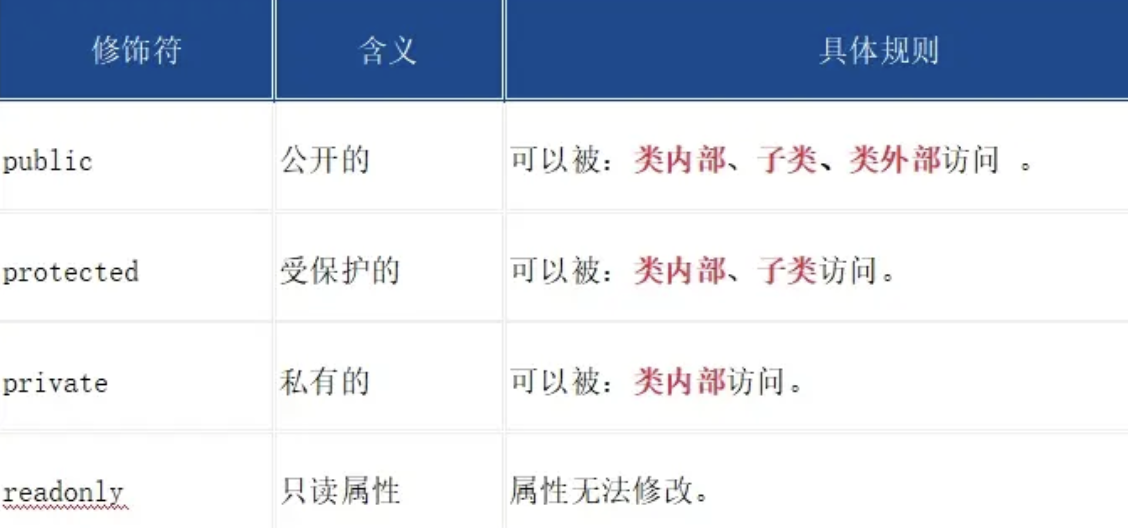Typescript 类相关
class Person {
// 属性声明
name: string
age: number
// 构造器
constructor(name: string, age: number) {
this.name = name
this.age = age
}
// 方法
speak() {
console.log(`我叫:${this.name},今年${this.age}岁`)
}
}
// Person实例
const p1 = new Person('周杰伦', 38)
class Student extends Person {
grade: string
// 构造器
constructor(name: string, age: number, grade: string) {
super(name, age)
this.grade = grade
}
// 备注本例中若Student类不需要额外的属性,Student的构造器可以省略
// 重写从父类继承的方法
override speak() {
console.log(`我是学生,我叫:${this.name},今年${this.age}岁,在读${this.grade}年级`,)
}
// 子类自己的方法
study() {
console.log(`${this.name}正在努力学习中......`)
}
}
属性修饰符

public 修饰符
class Person {
// name写了public修饰符,age没写修饰符,最终都是public修饰符
public name: string
age: number
constructor(name: string, age: number) {
this.name = name
this.age = age
}
speak() {
// 类的【内部】可以访问public修饰的name和age
console.log(`我叫:${this.name},今年${this.age}岁`)
}
}
const p1 = new Person('张三', 18)
// 类的【外部】可以访问public修饰的属性
console.log(p1.name)
class Student extends Person {
constructor(name: string, age: number) {
super(name, age)
}
study() {
// 【子类中】可以访问父类中public修饰的:name属性、age属性
console.log(`${this.age}岁的${this.name}正在努力学习`)
}
}
属性的简写形式
class Person {
public name: string;
public age: number;
constructor(name: string, age: number) {
this.name = name;
this.age = age;
}
}
class Person {
constructor(
public name: string,
public age: number
) { }
}
protected 修饰符
class Person {
// name和age是受保护属性,不能在类外部访问,但可以在【类】与【子类】中访问
constructor(
protected name: string,
protected age: number
) {}
// getDetails是受保护方法,不能在类外部访问,但可以在【类】与【子类】中访问
protected getDetails(): string {
// 类中能访问受保护的name和age属性
return `我叫:${this.name},年龄是:${this.age}`
}
// introduce是公开方法,类、子类、类外部都能使用
introduce() {
// 类中能访问受保护的getDetails方法
console.log(this.getDetails());
}
}
const p1 = new Person('杨超越',18)
// 可以在类外部访问introduce
p1.introduce()
// 以下代码均报错
// p1.getDetails()
// p1.name
// p1.age
class Student extends Person {
constructor(name:string,age:number){
super(name,age)
}
study(){
// 子类中可以访问introduce
this.introduce()
// 子类中可以访问name
console.log(`${this.name}正在努力学习`)
}
}
const s1 = new Student('tom',17)
s1.introduce()
private 修饰符
class Person {
constructor(
public name: string,
public age: number,
// IDCard属性为私有的(private)属性,只能在【类内部】使用
private IDCard: string
) { }
private getPrivateInfo(){
// 类内部可以访问私有的(private)属性 —— IDCard
return `身份证号码为:${this.IDCard}`
}
getInfo() {
// 类内部可以访问受保护的(protected)属性 —— name和age
return `我叫: ${this.name}, 今年刚满${this.age}岁`;
}
getFullInfo(){
// 类内部可以访问公开的getInfo方法,也可以访问私有的getPrivateInfo方法
return this.getInfo() + ',' + this.getPrivateInfo()
}
}
const p1 = new Person('张三',18,'110114198702034432')
console.log(p1.getFullInfo())
console.log(p1.getInfo())
// 以下代码均报错
// p1.name
// p1.age
// p1.IDCard
// p1.getPrivateInfo()
readonly 修饰符
class Car {
constructor(
public readonly vin: string, //车辆识别码,为只读属性
public readonly year: number,//出厂年份,为只读属性
public color: string,
public sound: string
) { }
// 打印车辆信息
displayInfo() {
console.log(`
识别码:${this.vin},
出厂年份:${this.year},
颜色:${this.color},
音响:${this.sound}
`);
}
}
const car = new Car('1HGCM82633A123456', 2018, '黑色', 'Bose音响');
car.displayInfo()
// 以下代码均错误:不能修改 readonly 属性
// car.vin = '897WYE87HA8SGDD8SDGHF';
// car.year = 2020;
抽象类
· 概述:抽象类是一种无法被实例化的类,专门用来定义类的结构和行为,类中可以写抽象方法,也可以写具体实现。抽象类主要用来为其派生类提供一个基础结构,要求其派生类必须实现其中的抽象方法。
· 简记:抽象类不能实例化,其意义是可以被继承,抽象类里可以有普通方法、也可以有抽象方法。
通过以下场景,理解抽象类:
我们定义一个抽象类Package,表示所有包裹的基本结构,任何包裹都有重量属性weight,包裹都需要计算运费。但不同类型的包裹(如:标准速度、特快专递)都有不同的运费计算方式,因此用于计算运费的calculate方法是一个抽象方法,必须由具体的子类来实现。
abstract class Package {
constructor(public weight: number) { }
// 抽象方法:用来计算运费,不同类型包裹有不同的计算方式
abstract calculate(): number
// 通用方法:打印包裹详情
printPackage() {
console.log(`包裹重量为: ${this.weight}kg,运费为: ${this.calculate()}元`);
}
}
StandardPackage类继承了Package,实现了calculate方法:
// 标准包裹
class StandardPackage extends Package {
constructor(
weight: number,
public unitPrice: number // 每公斤的固定费率
) { super(weight) }
// 实现抽象方法:计算运费
calculate(): number {
return this.weight * this.unitPrice;
}
}
// 创建标准包裹实例
const s1 = new StandardPackage(10,5)
s1.printPackage()
ExpressPackage类继承了Package,实现了calculate方法:
class ExpressPackage extends Package {
constructor(
weight: number,
private unitPrice: number, // 每公斤的固定费率(快速包裹更高)
private additional: number // 超出10kg以后的附加费
) { super(weight) }
// 实现抽象方法:计算运费
calculate(): number {
if(this.weight > 10){
// 超出10kg的部分,每公斤多收additional对应的价格
return 10 * this.unitPrice + (this.weight - 10) * this.additional
}else {
return this.weight * this.unitPrice;
}
}
}
// 创建特快包裹实例
const e1 = new ExpressPackage(13,8,2)
e1.printPackage()
总结:何时使用抽象类?
1. 定义通用接口:为一组相关的类定义通用的行为(方法或属性)时。
2. 提供基础实现:在抽象类中提供某些方法或为其提供基础实现,这样派生类就可以继承这些实现。
3. 确保关键实现 :强制派生类实现一些关键行为。
4. 共享代码和逻辑:当多个类需要共享部分代码时,抽象类可以避免代码重复。
interface(接口)
interface是一种定义结构的方式,主要作用是为:类、对象、函数等规定一种契约,这样可以确保代码的一致性和类型安全,但要注意interface只能定义格式,不能包含任何实现 !
定义类结构
// PersonInterface接口,用与限制Person类的格式
interface PersonInterface {
name: string
age: number
speak(n: number): void
}
// 定义一个类 Person,实现 PersonInterface 接口
class Person implements PersonInterface {
constructor(
public name: string,
public age: number
) { }
// 实现接口中的 speak 方法
speak(n: number): void {
for (let i = 0; i < n; i++) {
// 打印出包含名字和年龄的问候语句
console.log(`你好,我叫${this.name},我的年龄是${this.age}`);
}
}
}
// 创建一个 Person 类的实例 p1,传入名字 'tom' 和年龄 18
const p1 = new Person('tom', 18);
p1.speak(3)
定义对象结构
interface UserInterface {
name: string
readonly gender: string // 只读属性
age?: number // 可选属性
run: (n: number) => void
}
const user: UserInterface = {
name: "张三",
gender: '男',
age: 18,
run(n) {
console.log(`奔跑了${n}米`)
}
};
定义函数结构
interface CountInterface {
(a: number, b: number): number;
}
const count: CountInterface = (x, y) => {
return x + y
}
接口之间的继承
一个interface继承另一个interface,从而实现代码的复用
interface PersonInterface {
name: string // 姓名
age: number // 年龄
}
interface StudentInterface extends PersonInterface {
grade: string // 年级
}
const stu: StudentInterface = {
name: "张三",
age: 25,
grade: '高三',
}
接口自动合并(可重复定义)
// PersonInterface接口
interface PersonInterface {
// 属性声明
name: string
age: number
}
// 给PersonInterface接口添加新属性
interface PersonInterface {
// 方法声明
speak(): void
}
// Person类实现PersonInterface
class Person implements PersonInterface {
name: string
age: number
// 构造器
constructor(name: string, age: number) {
this.name = name
this.age = age
}
// 方法
speak() {
console.log('你好!我是老师:', this.name)
}
}
总结:何时使用接口?
1. 定义对象的格式: 描述数据模型、API 响应格式、配置对象........等等,是开发中用的最多的场景。
2. 类的契约:规定一个类需要实现哪些属性和方法。
3. 扩展已有接口:一般用于扩展第三方库的类型, 这种特性在大型项目中可能会用到。
一些相似概念的区别
1. interface 与 type 的区别
· 相同点:interface和type 都可以用于定义对象结构,在定义对象结构时两者可以互换。
· 不同点:
1️⃣interface:更专注于定义对象和类的结构,支持继承、合并。
2️⃣type:可以定义类型别名、联合类型、交叉类型,但不支持继承和自动合并。
// 使用 interface 定义 Person 对象
interface PersonInterface {
name: string;
age: number;
speak(): void;
}
// 使用 type 定义 Person 对象
type PersonType = {
name: string;
age: number;
speak(): void;
};
// 使用PersonInterface
/* let person: PersonInterface = {
name:'张三',
age:18,
speak(){
console.log(`我叫:${this.name},年龄:${this.age}`)
}
} */
// 使用PersonType
let person: PersonType = {
name:'张三',
age:18,
speak(){
console.log(`我叫:${this.name},年龄:${this.age}`)
}
}
interface PersonInterface {
name: string // 姓名
age: number // 年龄
}
interface PersonInterface {
speak: () => void
}
interface StudentInterface extends PersonInterface {
grade: string // 年级
}
const student: StudentInterface = {
name: '李四',
age: 18,
grade: '高二',
speak() {
console.log(this.name,this.age,this.grade)
}
}
// 使用 type 定义 Person 类型,并通过交叉类型实现属性的合并
type PersonType = {
name: string; // 姓名
age: number; // 年龄
} & {
speak: () => void;
};
// 使用 type 定义 Student 类型,并通过交叉类型继承 PersonType
type StudentType = PersonType & {
grade: string; // 年级
};
const student: StudentType = {
name: '李四',
age: 18,
grade: '高二',
speak() {
console.log(this.name, this.age, this.grade);
}
};
14.2. interface 与 抽象类的区别
· 相同点:都能定义一个类的格式(定义类应遵循的契约)
· 不相同:
1️⃣接口:只能描述结构,不能有任何实现代码,一个类可以实现多个接口。
2️⃣抽象类:既可以包含抽象方法,也可以包含具体方法, 一个类只能继承一个抽象类。
// FlyInterface 接口
interface FlyInterface {
fly(): void;
}
// 定义 SwimInterface 接口
interface SwimInterface {
swim(): void;
}
// Duck 类实现了 FlyInterface 和 SwimInterface 两个接口
class Duck implements FlyInterface, SwimInterface {
fly(): void {
console.log('鸭子可以飞');
}
swim(): void {
console.log('鸭子可以游泳');
}
}
// 创建一个 Duck 实例
const duck = new Duck();
duck.fly(); // 输出: 鸭子可以飞
duck.swim(); // 输出: 鸭子可以游泳
若非特殊说明,文章均属本站原创,转载请注明原链接。








